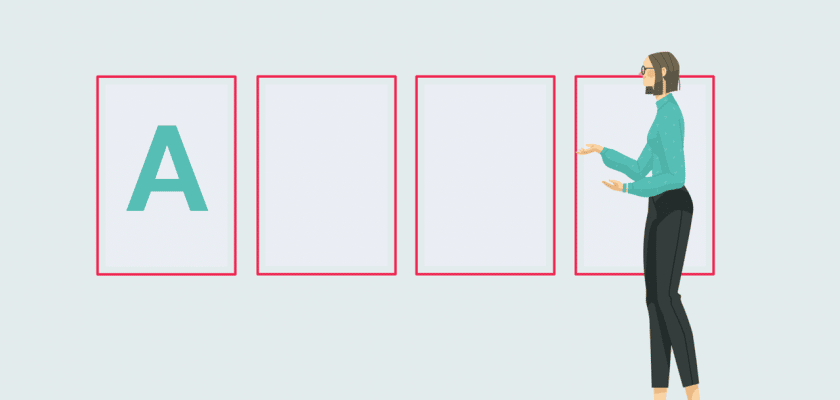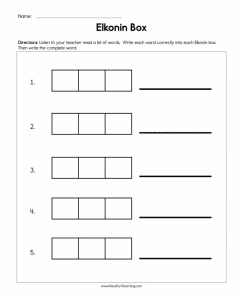Are any of the kids in your class among the nearly 30% of early readers who struggle to read? Using Elkonin boxes will help you to help them.
In this article, you will learn what Elkolin boxes are and how to use them. We’ll also give you some great ideas for activities in class that will help your kids recognize individual sounds, break words down and build them up again. In short, we’ll help you to use Elkonin boxes to help your kids to read.
Table of Contents
- What are Elkonin Boxes?
- Working with Elkonin boxes
- Phonemic Awareness Activities with Elkonin Boxes
- Elkonin Boxes Resources
- Elkonin Boxes FAQ
- Final Words
What are Elkonin Boxes?
An Elkonin box is literally a square drawn on a page. When a child hears a single sound in a word, they move a counter into the relevant box. This means that one Elkolin box corresponds to one individual sound (or phoneme) in a word.
To facilitate learning words of different lengths, the number of boxes on the page varies. Usually, about six boxes are drawn to accommodate the words being taught.
Benefits for Children
Elkonin boxes allow children to develop an awareness of the different sounds as the words are broken up into phonemes.
They are useful in guiding children to learn to count the different individual sounds in a word. This will help them to develop an awareness of the structure of words and how sounds work together.
Using Elkonin boxes involves the children using hearing and touch, which adds to the learning experience. Particularly children with barriers to learning become more aware of the different phonemes through this tool.

Working with Elkonin boxes
How Do They Work?
The child will listen to a word being pronounced and then broken into the individual sounds. For each sound, the child must put a counter into the Elkonin box. This encourages children to listen to and identify each individual sound in a word.
For example: In the word ‘cat,’ there are three separate sounds so that the child will move three counters into three different boxes.
In the word ‘bread’, there are four phonemes, so that the child will move four counters.
Uses of an Elkolin Boxes:
Segmenting
The learner is given a sheet with boxes printed on it. They listen to someone speaking out a word, separating the different individual sounds or phonemes. As the child hears a single sound, they move a token into one of the blocks.
The Literacy Intervention Packet: Phoneme Segmentation activity pack is a perfect resource to use with students.
Blending
Words with blended sounds are used for these activities. The words are read with each separate sound being emphasized. As the learners hear the blended sound, they will learn to recognize the sound and then learn what letters correspond to the sound and see that it is made of two letters.
Spelling
When a child hears a word and sees the way it is written, they are on the way to learning how it is spelled. The Elkonin boxes teach them to listen to the pronunciation of the individual sounds, which they can then recognize in other words and learn to spell.

Phonemic Awareness Activities with Elkonin Boxes
Working With Sounds
Elkonin boxes can be used to teach the pronunciation of CVC words by helping the children to learn the individual sounds.
Take a separate page for each word and draw three Elkonin boxes with a picture illustrating the word above them. Read the word to the students and guide them to work out how many individual sounds there are and what they sound like. They can then put a counter into each box when they hear the individual sounds.
Dot the Spot
Elkonin boxes can be used to help children identify the different parts of a word, such as the beginning, middle and end. With this activity, it is best to begin with CVC words because the phonemes are so simple. The children will listen to each word as it is read and identify one part of the word. For example, the beginning sound. When they hear that sound, they put a counter in the first box. Encourage the learners to repeat each of the sounds.
Building Words
When a student can identify the different sounds in a word and where they are, they can move on to working on how the words are built. For this activity, the children will use cards with the letters of the alphabet on them, rather than the counters. Give the learners the Elkonin worksheet, with the letter for each sound in the correct box. Practise saying the sounds and helping them recognise which letter goes with which sound. When they are good at this, remove the letter tiles from the sound boxes. Read each word again and the learners must put the letter for each sound into the correct box.
Changing Words
This is an activity that builds on the previous one. The learners should first build a word from the letter tiles. Choose a word that has one letter that is different and read that to the students. When they hear a different sound, they must remove that tile from the sound box. Guide the students to choose the correct letter for the sound that has changed.
Writing/Spelling Activity
Breaking up words and putting them together again is great for learning about spelling. When the children are familiar with a number of letters and their corresponding sounds, they can begin to spell words on their own, using Elkonin boxes. Read a word to the learners, breaking it up into the different phonemes. As they hear a sound, the learners must put the correct letter tile into the correct sound box. This will help them to learn to spell words based on the individual sounds.
Elkonin Boxes Resources
Printable CVC words
There are various resources available to work with Elkonin boxes. Printable worksheets and activity sheets are a great starting point. Editable sight word reading games make learning easier and more fun for both teachers and kids. You can also create your own activities and games using free CVC flashcards with pictures to print.
Phoneme Frames
Printable phoneme frames are also very useful as a basic kit to use with students.
Elkonin Boxes FAQ
Elkolin boxes and sound boxes are no different. They are both printed or drawn squares on a sheet into which buttons or flashcards can be inserted. In fact, Elkolin boxes are also known as ‘Elkolin sound boxes’.
When someone is learning to read, one of the key skills is to learn to pronounce words correctly by working to break a word up into individual sounds. Elkonin boxes are a fantastic tool to teach learners to do just this.
When you pronounce two letters together to produce a new individual sound, it is said to be blended. Elkonin boxes help students to identify the sound before they try to spell it.
Spelling a word is based on putting letters that correspond to sounds together. With Elkonin boxes, the students learn to build words sound by sound. They also learn which letters go with each sound. As they build words using the boxes, they learn to spell.
Final Words
You’ll have a better understanding now of what Elkonin boxes are and how they can benefit your children, especially those who are struggling to read. Make use of available resources and develop your own activities to make learning fun for students.

